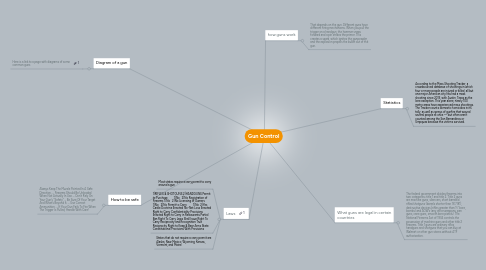Gun Control
by dawson savage

1. How to be safe
1.1. Always Keep The Muzzle Pointed In A Safe Direction. ... Firearms Should Be Unloaded When Not Actually In Use. ... Don't Rely On Your Gun's "Safety" ... Be Sure Of Your Target And What's Beyond It. ... Use Correct Ammunition. ... If Your Gun Fails To Fire When The Trigger Is Pulled, Handle With Care!
2. Diagram of a gun
2.1. Here is a link to a page with diagrams of some common guns
3. Laws
3.1. Most states require a carry permit to carry around a gun
3.2. 1)RIFLES & SHOTGUNS 2)HANDGUNS Permit to Purchase 1)No 2)No Registration of Firearms 1)No 2)No Licensing of Owners 1)No 2)No Permit to Carry 1)No 2)Yes Castle Doctrine Enacted No-Net Loss Enacted Right to Carry Confidentiality Provisions Enacted Right to Carry in Restaurants Partial Ban Right To Carry Laws Shall Issue Right To Carry Reciprocity and Recognition True Reciprocity Right to Keep & Bear Arms State Constitutional Provisions With Provisions
3.3. States that do not require a carry permit are Alaska, New Mexico, Wyoming, Kansas, Vermont, and Maine
4. Statistics
4.1. According to the Mass Shooting Tracker, a crowdsourced database of shootings in which four or more people are injured or killed, all but one major American city has had a mass shooting since 2013, with Austin, Texas as the lone exception. This year alone, nearly 100 metro areas have experienced mass shootings. The Tracker counts domestic homicides in its tally, as well as sprays of gunfire that wound several people at once — but often aren’t counted among the San Bernardinos or Umpquas because the victims survived.
5. how guns work
5.1. That depends on the gun. Different guns have different firing mechanisms. When you pull the trigger on a handgun, the hammer snaps forward and a pin strikes the primer. This creates a spark, which ignites the gunpowder, and the explosion propels the bullet out of the gun.
6. What guns are legal in certain countries
6.1. The federal government divides firearms into two categories; title 1 and title 2. Title 2 guns are machine guns, silencers, short barreled rifles/shotguns (barrels shorter than 16“/18“), destructive devices (rifles greater than ½” bore, bombs) and AOW’s (any other weapons; pen guns, cane guns, smooth bore pistols). The National Firearms Act of 1934 controls the possession of machine guns and other title 2 firearms. Title 1 guns are ordinary rifles, handguns and shotguns that you can buy at Walmart or other gun stores without ATF authorization.


